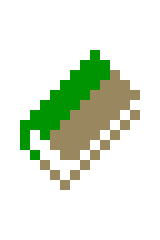On Humanoid Mimicry of Animals and Plants: Difference between revisions
Syntaxaire (talk | contribs) m (rm duplicate {{as of patch}}) |
imported>Trashmonks (Updated by syntaxaire with game version 2.0.200.71 using QBE v1.0rc2) |
||
| Line 1: | Line 1: | ||
<!-- START QBE: Autogenerated section - please leave this marker. See the [[QBE]] page for more information. --> | <!-- START QBE: Autogenerated section - please leave this marker. See the [[QBE]] page for more information. --> | ||
{{As Of Patch|2.0. | {{As Of Patch|2.0.200.71}} | ||
{{Item | {{Item | ||
| title = {{Qud text| | | title = {{Qud text|{{Qud shader|W|On Humanoid Mimicry of Animals and Plants}}}} | ||
| image = on humanoid mimicry of animals and plants.png | | image = on humanoid mimicry of animals and plants.png | ||
| weight = 1 | | weight = 1 | ||
Revision as of 16:51, 18 July 2020
| This information is reliable as of patch 2.0.200.71. If this is no longer the current patch, you can help by updating it. |
|
1 lb. Weight | |
Character
|
= |
|---|---|
ID?
|
OnHumanMimicry |
Book ID
|
Animals |
An unadorned codex of goatskin vellum.
On Humanoid Mimicry of Animals and Plants is a book.
Contents
Why do some creatures seem to prefer when we assume their likenesses while others hate it? As a zoologist, this question has interested me for some time. To address it, I must first draw a distinction between 'natural mimicry', where certain humanoids have developed animal and plant likenesses on a biological level, and 'unnatural mimicry', enacted in the forms of clothing and other decorative adornments. As for the former, it appears all creatures exhibit kinship toward humanoids who look like them in the biological sense. The latter scenario is the interesting one.
It's tempting to draw the divide between mammals and non-mammals, but the truth is more complicated than this. It's true that the only creatures who seem to take outright offense at mimicry are mammals, but there are documented cases of mammals accepting the mimic. For example, fork-horned helms endear their wearers to both antelopes and goatfolk.
On the contrary, ape fur clothing and puma chitin vests inflame apes and cats, respectively. The important detail here is the context in which the clothing is made. Poachers hunt apes and pumas specifically for their prized fur and chitinous shells, and being reasonably social creatures, both species take offense at the flaunting of these trophies. Birds, on the other hand, seem to know that feather harvesting can be (although isn't always) done without proving fatal for the bird in question, though another hypothesis points to birds' specific appreciation of plumage regardless of context.
Unshelled reptiles seem to have few qualms with mimicry, perhaps believing the mimics to be truly reptile in part. Mollusks, trees, and insects all tend to identify with shell-bearers, leaf-donners, and firefly-symbiotes, respectively.
Without exception, however, all creatures seem to detest the practice of wearing the severed faces of their kin. Curious.
